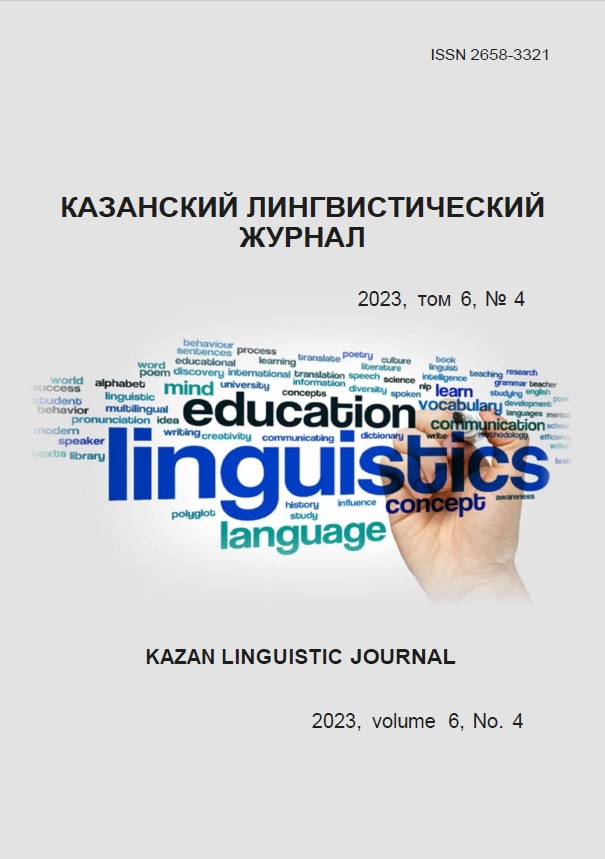Approaches to the Study of the Expression of Positive and Negative Emotions in the Text
https://doi.org/10.26907/2658-3321.2023.6.4.481-489
Keywords:
language, emotion, linguistics, functional-semantic, language system, expressive lexiconAbstract
This article discusses the problem of expressing positive and negative emotions in a modern text using a functional-semantic approach. Currently, texts are the subject of active research, since they fully reflect human nature. It should also be noted that the theories of text construction are insufficiently developed and little studied in linguistics. Despite the fact that a large number of scientific articles are devoted to textual problems, the construction of a holistic theory of text is an area of modern linguistic research. Currently, the ways of expressing emotions in the text are one of the urgent problems of communicative linguistics. The main purpose of this work is to study the methodological foundations of the study of positive and negative emotions in texts. The scientific works considering expressions of positive and negative emotions in texts from the point of view of the functional-semantic approach are studied. When studying this approach, we decided to use the following scientific methods: the method of analysis and the method of synthesis, induction and deduction, comparative and logical analysis, as well as objective scientific, systematizing positions.
References
References
Sakaeva L.R., Ermolenko A.Yu. Problems of translating film names based on the material of English and Russian languages. Kazan linguistic journal. 2020;1(3):41–51. DOI: 10.26907/2658-3321.2020.3.1.41-51
Ogudo K.A., Nestor D.M.J. Sentiment analysis application and natural language processing for mobile network operators' support on social media. 2019. Available from: https://ieeexplore.ieee.org/document/8851052. [accessed: 02.11.2023]
Inoue K., Hara S., Abe M., Hojo N., Ijima Y. Model architectures to extrapolate emotional expressions in DNN-based text-to-speech. Speech Communication. 2021;(126):35–43.
Brown J.A., Knollman-Porter K., Hux K., Wallace S.E., Deville C. Effect of digital highlighting on reading comprehension given text-to-speech technology for people with aphasia. Aphasiology. 2021;35(2):200–221.
Chen J., Ye L., Ming Z. MASS: Multi-task anthropomorphic speech synthesis framework. Computer Speech and Language; 2021. 70. Article number: 101243.
Glazer T. On the virtual expression of emotion in writing. British Journal of Aesthet-ics. 2017;57(2):177–194.
Robus C.M., Hand C.J., Filik R., Pitchford M. Investigating effects of emoji on neu-tral narrative text: Evidence from eye movements and perceived emotional valence. Computers in Human Behavior; 2020. 109, Article number: 106361.
Otamendi F.J., Sutil Martin D.L. The emotional effectiveness of advertisement. Frontiers in Psychology. 2020. 11. Article number: 2088.
Chakraborty B., Geetha M. Emotion recognition in a conversational context. Com-munications in Computer and Information Science. 2018;(950):208–214.
Mircoli A. Automatic emotional text annotation using facial expression analysis. 2017. Available from: http://ceur-ws.org/Vol-1848/CAiSE2017_DC_Paper4.pdf. [accessed: 29.10.2023]
Mullagayanova G.S. Color designation of emotions in the English language. Middle East Journal of Scientific Research. 2013;15(6):902–906.
Lazemi S., Ebrahimpour-Komleh H. Multi-emotion extraction from text based on linguistic analysis. 2018. Available from: https://ieeexplore.ieee.org/document/8387233. [accessed: 15.10.2023]
Roos J., Oliver D. Beyond text: Constructing organizational identity multimodally. British Journal of Management. 2018;18(4):342–358.






